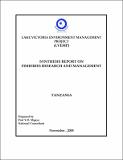| dc.description.abstract | Lake Victoria is the largest tropical lake in the world with a surface area, 68,800 km2 (Bootsma and Hecky 1993). The lake is shared by three countries, with 51% share in Tanzania, 43% in Uganda, and 6% in Kenya. Its land catchment area of 193,000 km2 is distributed as follows: Tanzania 44%, Kenya 22%, Uganda 16%, Rwanda 11%, and Burundi 7%. The shoreline of the lake is approximately 3,450 km, 50 % (1,750 km) is in Uganda, 33% (1,150 km) is in Tanzania and 17% (550 km) is in Kenya. The Lake Victoria is endowed with invaluable fishery resources that are contributing enormously to the livelihood of the communities and the riparian states in terms of food security, employment, wealth generation, foreign earnings and other multiplier effects. The lake (Tanzania side) accounts for over 60% of the total national inland fish production. The lake is also an important source of water for domestic, industrial and small scale agriculture. It is also an important transport corridor between major towns around the lake and a number of villages, settlements, beaches and numerous islands. Steady population growth in the lake basin over the years resulted in deterioration of water quality and fisheries resources. Consequently Lake Victoria Environmental Management Project (LVEMP) was started in 1997 as a five-year project with the main aim to rehabilitate the ecosystems in and around the lake with a long-term objective to introduce environmentally and socially sustainable economic development in the three riparian governments of Kenya, Tanzania and Uganda. The volume of data and information generated by Fisheries Research and Fisheries Management components of LVEMP during the 8 years of implementation of Phase 1 of the LVEMP activities from July, 1997 to June 2002 and a bridging period of 3 years and half which extended the project from July 2002 to December 2005, promted the three riparian countries of Kenya, Uganda and Tanzania together with GEF and the World Bank to consider conducting an exercise to analyze, consolidate and synthesize data and knowledge generated during the period. This assignment was accomplished through a consultancy which involved one International Consultant and one National Consultant assisted by the Project Component Coordinators and Task Leaders of the Project and under the over all coordination of the LVEMP Secretariat. | en_US |

